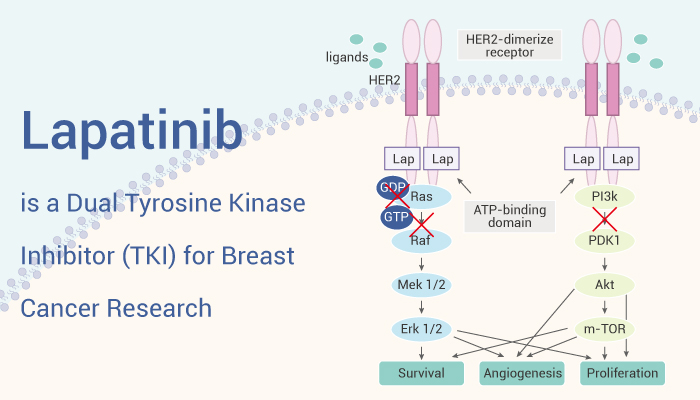ErbB is a transmembrane receptor tyrosine protein kinase, ErbB receptor family. This family is a subfamily of four closely related receptor tyrosine kinases: EGFR (ErbB-1), HER2/neu (ErbB-2), Her 3 (ErbB-3), and Her 4 (ErbB-4). Excessive ErbB signaling is associated with the development of multiple types of solid tumors. In particular, ErbB-1 and ErbB-2 are present in many human cancers. Here we introduce an orally active ErbB1/2 inhibitor, Lapatinib (GW572016).

Lapatinib induces cancer apoptosis and shows anti-cancer activity.
Firstly, Lapatinib has IC50 values of 10.2 and 9.8 nM for purified EGFR and ErbB-2, respectively. And then, Lapatinib’s ability to inhibit c-Raf-1, MEK, and the extracellular signal-regulated kinase cascade. In BT474 (breast) and HN5 (head and neck) cells, it (0.03-10 µM; 6 h) inhibits EGFR and ErbB-2 receptor autophosphorylation, as well as phosphorylation of AKT at serine 473. Lapatinib has the ability to induce cancer cell death due to AKT phosphorylation associated with inhibition of the apoptotic pathway. And Lapatinib (10 µM; 72 h) can induce cell cycle arrest in the G1 phase and selectively inhibit the proliferation of human tumor cell lines.
Lapatinib has anticancer activity against a variety of cancer cell lines, including HN5 (head and neck), A-431 (vulva), BT474 (breast), CaLu-3 (lung), and N87 (gastric). In a CD-1 nude female mouse in vivo model, lapatinib (30 mg/kg, 100 mg/kg; po; twice daily; 21 days) inhibited tumor xenograft growth of HN5 cells in a dose-response manner. Lapatinib (100 mg/kg) completely inhibits tumor growth with no significant effect on mouse body weight.
In summary, Lapatinib is an orally effective EGFR/ErbB-2 dual inhibitor that induces apoptosis and has anti-proliferative activity against a variety of cancer cells.
Reference:
[1] Rusnak DW, et al. Mol Cancer Ther. 2001 Dec;1(2):85-94.